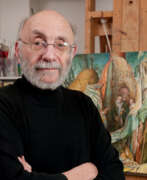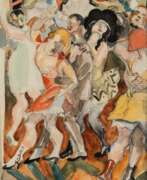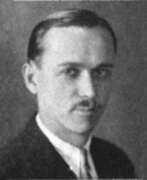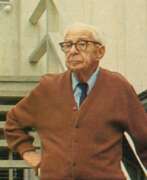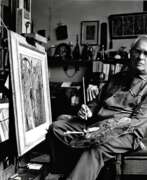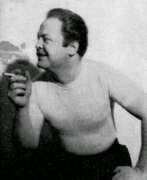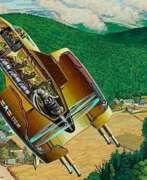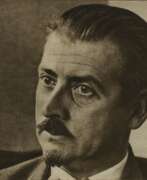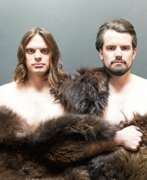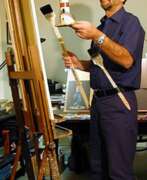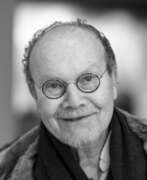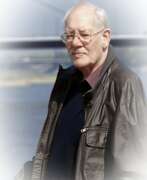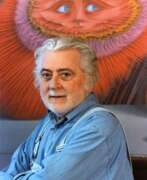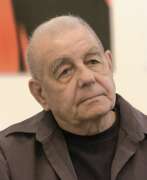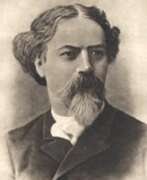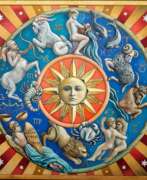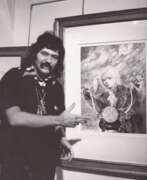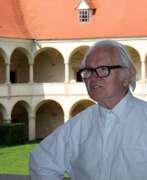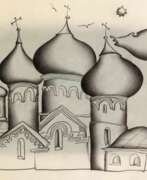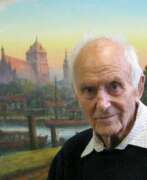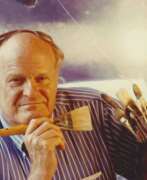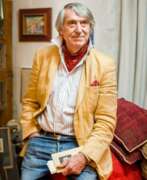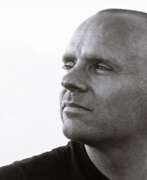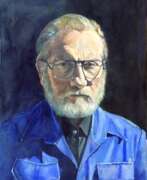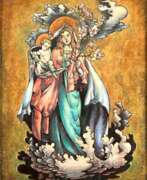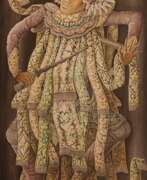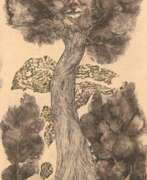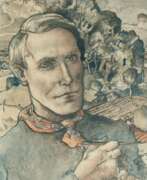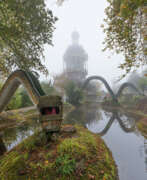Artists Fantastic Realism
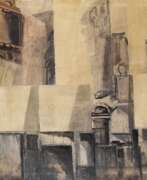

Peter Ackermann was a German painter and graphic artist. He became known for his alienation of architectural subjects. Ackermann was a representative of fantastic realism. The preferred subject of his work was classical Italian architecture, which he drew on site. He put together columns, portals and walls with machine parts, ruins and desolate parts of the city, which were piled up threateningly and thus alienated. In his etchings he showed references to the techniques of the old masters, his pictorial conception is compared with that of Giovanni Battista Piranesi and Canaletto.
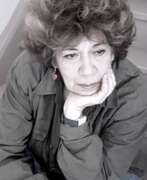

Margit Balla is a Hungarian artist, graphic artist, illustrator, director, stage designer and costume designer.
She studied typography at the Academy of Applied Arts in Budapest, mainly making posters, book illustrations, later working more and more with pictorial graphics. In her posters Margit Balla combines impressions from old prints with contemporary trends such as pop art. Her figurative compositions are easily recognizable by her special surrealistic drawing style.
Since 2000, Margit Balla has been working as a production designer for the Budapest Puppet Theater.
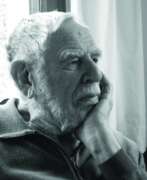

Moritz Baumgartl is a German painter, graphic artist and university professor living in Stuttgart.
Moritz studied at the Stuttgart State Academy of Fine Arts and worked for a long time as an art teacher at the Friedrich Eugens Gymnasium in Stuttgart. Baumgartl founded the art group "Stuttgart School" together with the artists Axel Arndt and Adam Lüde Döring.
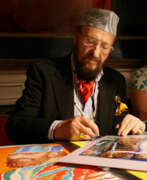

Ernst Fuchs was an Austrian painter, draftsman, printmaker, sculptor, architect, stage designer, composer, poet, and one of the founders of the Vienna School of Fantastic Realism. In 1972, he acquired the derelict Otto Wagner Villa in Hütteldorf, which he restored and transformed. The villa was inaugurated as the Ernst Fuchs Museum in 1988.
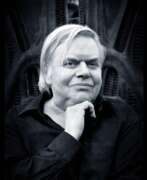

Hans Ruedi Giger was a Swiss artist best known for his airbrushed images that blended human physiques with machines, an art style known as "biomechanical". Giger later abandoned airbrush for pastels, markers and ink. He was part of the special effects team that won an Academy Award for the visual design of Ridley Scott's 1979 sci-fi horror film Alien, and was responsible for creating the titular Alien itself. His work is on permanent display at the H.R. Giger Museum in Gruyères, Switzerland. His style has been adapted to many forms of media, including album covers, furniture, tattoos and video games.
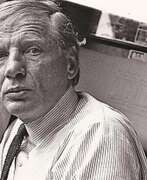

Rudolf Hausner was an Austrian painter, draughtsman, printmaker and sculptor. Hausner has been described as a "psychic realist" and "the first psychoanalytical painter".
A characteristic of his painting technique is the use of translucent ("glazing") resin oil paints in more than ten layers on top of each other over underpainting of acrylic paints, which gives the paint a special luminous depth. He also developed methods to create flawless transitions in pure oil painting without the use of an airbrush.


Wolfgang Herzig was an Austrian painter and sculptor known for his critical portrayal of social realities. In his figurative paintings he draws attention to human weaknesses in everyday life.
There is a sense of social criticism in Herzig's work, but he never turns his characters into caricatures. Over time, the artist came to a peculiar two-dimensional form of plastics.
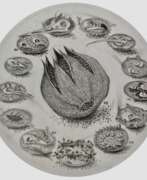

Hipkiss is the pseudonym of Alpha and Christopher Mason, both artists born in 1964 in Britain.
The artists began working together in the UK, then moved to France, where they continue to live and work. They are known for detailed, detailed figurative drawings created in a mixed media technique that combines pencil, silver ink and metallic foil. The artists draw large-scale urban landscapes, landscapes, strange insects, plants and birds, depicting images of a utopian future where nature has conquered the industrial environment.
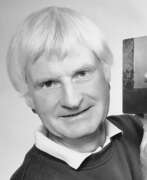

Horst G. Loewel is a German-born painter who lives and works in Canada and Spain.
Loewel is a representative of the fantastical-surrealistic trend in art. He meticulously and realistically depicts landscapes of another universe filled with symbolism. Thanks to his boundless imagination, the artist shows us a fabulous, unreal world in which man has almost no place.
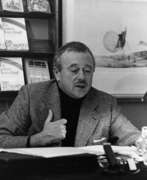

Roger Loewig was a German artist, illustrator and writer.
In addition to working as a teacher of Russian, German and history, Loewig independently practiced painting and drawing. In 1963, he organized an exhibition of his work, but was arrested on charges of "incitement endangering the state". Most of his paintings and literary texts were confiscated.
In 1972, he left for the Federal Republic of Germany, where he found recognition for his talent. Along with Günter Grass, Christoph Meckel and others, he joined the wide circle of "Berlin poets-artists", and Loewig's visual art became recognized as fantastic realism. Loewig's artworks and texts about war, flight, exile, and unfreedom placed him among the most important German artists of the postwar period.


Raymundo Martinez is a Mexican landscape painter and printmaker. His subject matter is the reinterpretation of the Mexican landscape: he painted the vast expanse of land, creating an ideal environment for the rapid growth of the metropolis.
The president of the country, Adolfo López Mateos, was a patron of the artist from 1958 to 1964 and willingly presented his works to heads of state. The works of Raimundo Martínez can be found in various Mexican embassies around the world, as well as in the collections of national political figures.
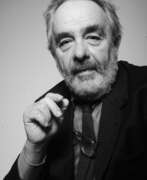

Arnulf Rainer is an Austrian artist who painted in the genre of informal abstract art.
From his early works the artist was inspired by the ideas of Surrealism. He also created works of art where he applied paint over photographs and works of other artists.
In the 1950s, Rainer painted a series of blindfold paintings in the technique of Surrealist automatism. In 1978 he received the Austrian Grand National Prize. Rainer has exhibited in New York, London, Vienna, Paris, Berlin and Munich. His works are in the collections of the Albertina, the Pompidou Center, the Stedelijk Museum, the Metropolitan Museum of Art and the Museum of Modern Art.
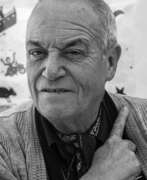

Raymond-Émile Waydelich is a French-Alsatian painter, sculptor and action artist. He lives and works in Hindisheim/Alsace.
Waydelich's extensive oeuvre includes paintings, sculptures and sculptures in ceramic or bronze, assemblages, works on paper as well as public art actions and performances. The artistic techniques of his colourful, playful, witty and whimsical graphics range from drawing, watercolour, lithography, etching and monotype to overpaintings of found paper objects.
He is one of France's best-known living artists. His works are in numerous public and private collections worldwide. His watercolour collages have become particularly famous, showing real-life creatures (crocodile, cat, pig) ghostly alienated within landscapes, which the artist painted on antique letters, some of which he acquired on journeys (e.g. to Crete). His style, which often takes up perspectives, motifs and elements of prehistoric cave paintings or Greek mythology, approaches fantastic realism.
